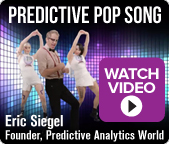Conference Day 1: Tuesday, May 16, 2017
Registration • Room: Grand Assembly
Networking Breakfast • Room: Salon 9
Conference Chair Welcome • Room: Salon 8
8:50-9:40am • Room: Salon 8
KEYNOTE
The Right Analytics for the Job: Tips and Tricks for Success
Welcome to the Analytics Explosion! Despite speculation that the need for analytics would begin to level-off, evidence suggests it continues to be at an all-time high. Trends show the establishment of more and more in-house analytics teams, allowing the luxury of predictive and prescriptive analytics to be applied across all levels of an organization. However, many factors should be considered when evaluating an analytics undertaking, such as complexity of the problem, precision necessary in the solution, and timeliness required for the response. With so many variables, how do you choose the right analytics tool for the job? What else is required for an analytics effort to be successful? Leveraging a dynamic analytical approach will achieve the greatest value for your business.
[ Top of this page ] [ Agenda overview ]
9:40-10:00am • Room: Salon 8
Diamond Sponsor Presentation
Automated machine learning with DataRobot
Predictive modeling using machine learning techniques is transforming every aspect of modern business. Traditional approaches to machine learning is a time-consuming, resource-intensive and highly error-prone process. Automated machine learning platforms can make the process of building highly accurate predictive models fast and efficient. In this session, we will show how Datarobot can collaborate with data scientists to quickly build hundreds of highly accurate predictive models in a transparent and flexible manner, generate deep insights and deliver immediate value to business with easy deployment options.
10:00-10:30am • Room: Salon 9
Exhibits & Morning Coffee Break
10:30-11:15am • Room: Salon 5 & 6
 Track 1: Analytics Management/Team-Building
Track 1: Analytics Management/Team-Building
Need a Data Scientist, Try Building a "DataScienceStein"
Organizations are looking at new approaches to finding data scientists due to the high demand, low supply economics of the talent pool. This is leading to a situation of the "haves" versus the "have-nots" where the larger, financially rich organizations in the "sexy" industries are most capable of attracting and hiring data scientists, while the lesser companies will have to make do without one. One approached being considered is building the data scientist function out of a team of people currently on staff or readily available in the marketplace, also known as the "DataScienceStein" approach.
10:30-11:15am • Room: Salon 8
 Track 2: Model Interpretation
Track 2: Model Interpretation
Case Study: SmarterHQ
When Model Interpretation Matters: Understanding Complex Predictive Models
Session description coming soon. Check back.
10:30-10:50am • Room: Salon 3 & 4
 Track 3: Churn Modeling; Best Practices
Track 3: Churn Modeling; Best Practices
Predicting Churn - An Often Not-So-Easy Task
Churn modeling is not new, yet the development of these models poses one significant challenge. Defining the target variable of churn is often unclear, as customers typically do not express their desire to cancel their relationship with a given company. Despite this challenge, methodologies exist to better define the target variable of churn which will often be specific for a given company and industry. Various case studies are presented across a variety of industries, which illustrate the methodology and discipline that is required in identifying the target variable of churn.
10:55-11:15am • Room: Salon 3 & 4
 Track 3: B2B Churn Modeling
Track 3: B2B Churn Modeling
Case Study: 7Geese
Using Predictive Analytics to Improve Customer Retention
Churn modeling is not new, yet the development of these models poses one significant challenge. Defining the target variable of churn is often unclear, as customers typically do not express their desire to cancel their relationship with a given company. Despite this challenge, methodologies exist to better define the target variable of churn which will often be specific for a given company and industry. Various case studies are presented across a variety of industries, which illustrate the methodology and discipline that is required in identifying the target variable of churn.
[ Top of this page ] [ Agenda overview ]
11:20am-12:05pm• Room: Salon 5 & 6
 Track 1: Analytics Project Management
Track 1: Analytics Project Management
Case Study: Cisco
The Role of Decision Modeling in Creating Data Science Excellence
Cisco's Data Science Office focuses not just on data science, but also on shaping the questions and answers for Cisco's operational groups. They focus not on technology or algorithms but on team building, problem solving, environment and community. One critical success factor has been using decision modeling to create Business Understanding - the first step in the CRISP-DM methodology that Cisco uses. Clear and shared understanding of the business problem frames the analytics to be developed and ensures those analytics can be operationalized. This session shows how decision models support Business Understanding, set up effective development, and drive successful analytic deployment.
11:20am-12:05pm • Room: Salon 8
 Track 2: Retail Analytics
Track 2: Retail Analytics
Case Study: SmarterHQ
Automated Retail Analytics - Omni-Channel and at Scale
In this session, I will discuss automation strategies currently behind SmarterHQ's storefront product. Here we combine entity analytics, predictive analytics and data processing into a scalable and flexible platform. This enables actionable customer intelligence delivery in near real time for onsite experience and market campaign generation updated every 20 minutes. This technology built on top of AWS redshift and python. This technology combines digital and analog retail channels into an omni-channel experience. I will discuss the significant aspects of this technology and its flexibility and scalability to new technology and customers.
11:20-11:40am • Room: Salon 3 & 4
 Track 3: Retention with Email Marketing
Track 3: Retention with Email Marketing
Case Studies: ILovemakeup, StarShop, Tibiona, Collectomania (eCommerce in EMEA)
7 Examples of Customer Retention with Predictive Email Marketing
This presentation covers the use of predictive email marketing for four eCommerce websites in Europe and Asia. We boosted engagement, reduced churn rate, drove more conversions, and increased revenue from every email campaign our clients ran. To this end, we employed behavior and product-based clustering to create in-depth customer profiles, including portraits and predictions on the lifetime value of each customer, their click rates, likelihood of purchasing or to churn. In the end, we found that our forecasting can predict what affects the subject line, timing, number of emails, and discount offers have on CTR and conversion rates. As a result, we have seen a 50% increase on average on click-through rates and a 100% increase in conversions.
11:45am-12:05pm • Room: Salon 3 & 4
 Track 3: Gaming Analytics; Marketing Segmentation for Churn Modeling
Track 3: Gaming Analytics; Marketing Segmentation for Churn Modeling
Case Study: A Leading Gaming Company
Identifying Unique Gamer Types Using Predictive Analytics
To create customer segmentation for its upcoming release of a new game title, the studio turned to its single largest asset of information - their beta users. By developing a customized survey with questions ranging from content preferences to spending habits, the studio was able to collect and mine the data they needed to make a crucial set of early business decisions. Not only did this information aid in predicting which customers were most likely to churn, it also helped define which marketing tactics would be most effective for each of its unique customer segments.
[ Top of this page ] [ Agenda overview ]
Lunch in the Exhibit Hall
1:45-2:30pm • Room: Salon 8
KEYOTE
Case Study: FICO
Fraud Screening for 2/3rds of All Card Transactions: A Consortium and Its Data
FICO scores 65% of all the world's payment card transactions for fraud. It accomplishes this by maintaining a payment card transaction consortium utilized in the production of the Falcon platform, which monitors a majority of the world's payment cards. Maintaining this data consortium poses challenges given the large number of financial services contributors. FICO utilizes analytics ranging from automated statistical testing, massive model robustness tests, outlier analytics, and auto-encoder technologies focused on ensuring data quality and integrity. Learn how FICO tackles the consortium with advanced analytics to monitor new trends in the global payment card space and ferrets out new transaction patterns used to protect your payment card.
2:40-3:25pm • Room: Salon 5 & 6
 Track 1: Thought leadership; Analytics Management
Track 1: Thought leadership; Analytics Management Case Study: Wells Fargo
Strategic Communication: Building a Bridge From Analytics to Business
You have successfully hired and developed a world class analytic team. Now for the hard part: making sure the business knows about and takes full advantage of the powerful asset you have built. A solid, well executed communications strategy starts with a cogent walk-around deck that delivers a clear description of what your team brings to the business. It is articulated in language that resonates with your partners and gets them thinking about how they need your team. Roll out your message through personal one-on-ones, brown-bags and partner meetings. Maintain the momentum using your company's intranet and encouraging testimonials.
2:40-3:25pm • Room: Salon 8
 Track 2: Best Practices
Track 2: Best Practices
Q&A: Ask Karl and Steven Anything (about Best Practices)
Beyond the Arc CEO Steven Ramirez, along with Rexer Analytics president Karl Rexer, field questions from an audience of predictive analytics practitioners about their work, best practices, and other tips and pointers.
2:40-3:25pm • Room: Salon 3 & 4
 Track 3: Seasonality and Other Contextual Factors
Track 3: Seasonality and Other Contextual Factors
Case Study: Paychex
Retention Modeling in Uncertain Economic Times
Small businesses are susceptible to even minor changes in economic conditions. When strategically allocating retention efforts across half a million businesses, we need to account for said changes as well as maximize our resource allocations. Traditional modeling techniques can fail over time in the presence of concept drift. We devised an innovative method to account for unknown changes by using seasonal model and trend model to probabilistically assign retention efforts. Additionally we built in functionally that allows new variables to be considered for development as they become relevant. This new methodology removes the necessity for annual retools and stabilizes performance.
[ Top of this page ] [ Agenda overview ]
Exhibits & Afternoon Break
3:55-4:15pm • Room: Salon 5 & 6
 Track 1: Thought Leadership; Analytics Management • Room: Salon 5 & 6
Track 1: Thought Leadership; Analytics Management • Room: Salon 5 & 6
Case Study: Dow Chemical Company
Creating an Industrial Revolution for Analytics
Most of analytics modeling work today focuses on the production of single-purpose "artisanal" models for predictions. This approach to analytics is fragile with respect to model consistency, reorganizations, and resource availability. This talk will argue that instead the focus of analytics modeling should be toward the production of analytics interchangeable parts, which can be combined in creative ways to produce a wide variety of analytics results. This "nuts and bolts" approach allows analytics groups to produce results in an agile way where the time between ask and answer is determined by the right combination of analytics, rather than the modeling.
4:20-4:40pm • Room: Salon 5 & 6
 Track 1: B2B; Text Analytics
Track 1: B2B; Text Analytics
Case Study: Dow Chemical Company
Listening Down the Value Chain: Using Text-based Predictive Models to Find New Opportunities for B-to-B Businesses
As many product innovations are driven by end-user feedback, B-to-B businesses are challenged with developing new technologies ahead of emerging consumer needs. The Dow Chemical Company helps its business units with this challenge through an internal market insights service offering. This multi-functional team assists in directing the business units to the appropriate capability, such as licensed self-service analytics tools, external consultancy engagements, or in-house text analytics solutions. In this talk, we will describe the service architecture and provide an example of how we have developed market listening predictive models to enhance growth for our businesses.
 Track 2: Open Source Demo; Text Analytics
Track 2: Open Source Demo; Text AnalyticsSemantic Natural Language Understanding with Spark, Machine-Learned Annotators & Deep-Learned Ontologies
This is a live demo of an end-to-end system that makes nontrivial clinical inferences from free-text patient records. Infrastructure components include Kafka, Spark Streaming, Spark & Elasticsearch; data science components include custom annotators, curated taxonomies, machine-learned dynamic ontologies, and real-time inferencing. The design is based on open-source components, and notebooks with the full code will be publicly available.
3:55-4:40pm • Room: Salon 3 & 4
 Track 3: Churn Modeling
Track 3: Churn ModelingCase Study: LinkedIn
Predicting Customer Churn in a Subscription Business
A subscription business relies on ongoing renewal of the customer base. The goal is to increase the customers that will renew and minimize the ones that will churn. A very useful strategy is to predict the customers that have a high propensity to churn in advance of their renewal, thus allowing opportunities to direct retention efforts.
This session will discuss how to build a predictive model to identify and score customers most likely to churn. We will discuss potential modeling variables and how to determine the most influential variables to use and the steps in building the model.
[ Top of this page ] [ Agenda overview ]
4:45-5:05pm • Room: Salon 5 & 6
 Track 1: Advertising
Track 1: Advertising
Case Study: Visible World (A Comcast Company)
Predictive Analytics for Yield Management
Predictive Analytics is used today to solve a wide range of complex business problems. Recently, with the advent of new advanced data sources, the advertising industry has placed more emphasis on using predictive methods to help generate greater yield from ad sales. This presentation highlights novel uses of predictive technologies to drive advertising revenue growth.
5:10-5:30pm • Room: Salon 5 & 6
 Track 1: Acquisition Funnel for Higher Education
Track 1: Acquisition Funnel for Higher Education
Case Study: Becker College
Enhancing the Quality of Predictive Modeling on College Enrollment
Predictive modeling has gained popularity in studying college enrollment due to fierce competition in higher education. To make informed decisions and allocate limited resources to improve enrollment, predictive modeling has been applied to challenge and change the traditional recruitment process. This session is intended for two learning outcomes:
- Participants who are not familiar with predictive modeling will learn how to lay out a plan to collect and build a comprehensive data infrastructure and conduct predictive modeling.
- Participants who have run predictive modeling will learn how to critically examine the quality of their predictive analyses.
 Feyzi Bagirov
Feyzi BagirovChief Business Officer, 592 LLC
Analytics Instructor, Harrisburg University of Science and Technology
 Track 2: Analytics Software
Track 2: Analytics SoftwareData Science Hype vs Reality: "Big Data" vs Single Machine Tools
While extracting business value from data has been performed by practitioners for decades, the last several years have seen an unprecedented amount of hype in this field, much of it related to dataset size ("big data") and the new "scalable" tools for analytics. In this talk I will use quantitative measurements to argue that most practitioners work with data that can be analyzed by single-machine tools (e.g. R/Python) and that these tools outperform "big data" tools in many common scenarios. I will also present a benchmark comparing the performance of several open source machine learning libraries (R, Python sklearn, H2O, Spark MLlib and xgboost) and show that high-performance computing (rather than "big data") roots lead to significant (10x) performance improvement.
4:45-5:30pm • Room: Salon 3 & 4
 Track 3: Churn Modeling with Deep Learning; B2B
Track 3: Churn Modeling with Deep Learning; B2B
Case Study: Microsoft
How Microsoft Predicted Churn of Cloud Customers Using Deep Learning and Explained Predictions in An Interpretable Way
Although deep learning has proved to be very powerful, few results are reported on its application to business-focused problems. This session highlights the best practice to build a deep learning based churn predictive model at Microsoft. Moreover, we will explain the predictions using LIME, a novel algorithm published in KDD 2016, to make the "black box" models more transparent and accessible.
[ Top of this page ] [ Agenda overview ]
Networking Reception
Dinner with Strangers
Sign up in advance at the eZone
Bay Area SAS Users Group Meeting
Bay Area SAS Users Group is a local users group organized to further the interests of programmers and users of the SAS® Software in the San Francisco Bay Area, and to instruct members how to better use SAS® programming tools and user interfaces. Bay Area SAS Users Group also provides an arena for informing attendees and members of career opportunities.
This meeting will include the following discussion topics and speakers:
Keeping Passwords, AES Encryption Keys, and Other Sensitive Parameters Out of Source Code and Logs
Thomas E. Billings, MUFG Union Bank, N.A., San Francisco, California
SAS/Twilight Zone
Kevin Graham, Montura
The LUCID Principles in Spec-Writing
Albert Mo, Independent Consultant
For more information on the event, please visit www.basas.com
Conference Day 2: Wednesday, May 17, 2017
8:00-9:05am • Room: Grand Assembly
Registration
Networking Breakfast
Special Plenary Session
What to Optimize? The Heart of Every Analytics Problem
Every analytics challenge reduces, at its technical core, to optimizing a metric. Product recommendation engines push items to maximize a customer's purchases; fraud detection algorithms flag transactions to minimize losses; and so forth. As modeling and classification (optimization) algorithms improve over time, one could imagine obtaining a solution merely by defining the guiding metric. But are our tools that good? More importantly, are we aiming them in the right direction? I think, too often, the answer is no. I'll argue for clear thinking about what exactly it is we ask our computer assistant to do for us, and recount some illustrative war stories. (Analytic heresy guaranteed.)
10:00-10:20am • Room: Salon 5 & 6
 Track 1: Financial Service Applications
Track 1: Financial Service Applications Case Study: Bizfi
How Predictive Analytics Can Drive Success in Fintech and Banking
Financial technology, or fintech, is helping to create new products and new customer experiences in financial services. Alternative lenders, payment platforms, and other new fintech players are leveraging predictive analytics to architect many of these new offerings. In this session, you'll learn how Bizfi has deployed advanced analytics across several functional areas of the company and transformed their business. Steven will discuss Bizfi's experiences, and the best practices that others can apply to accelerate the adoption of predictive analytics in their own organizations.
10:25-10:45am • Room: Salon 5 & 6
 Track 1: Product Design Analytics
Track 1: Product Design Analytics Case Study: GoPro
Making Better Products with Predictive Analytics
How do you improve a product or service using predictive analytics? We are at the precipice of the IoT and smart device data generating wave where the data represents how customers are using their devices and services. Consumers and their devices are communicating directly with companies now. If you are listening you can predict what features they like, dislike, want, and will use in the future. You can also predict device and service performance issues and improvements. We are in a time where we can answer strategic, tactical, and performance level business questions.
10:00-10:45am • Room: Salon 8
 Track 2: External Data
Track 2: External Data
Case Study: Google
Machine Learning Models for Assessing Third Party Signals
Purchasing 3rd party data (from vendors) for marketing/advertising is a common task. Frequently though, companies decide a price and make decisions based on experience or expensive real world tests; given the volume of businesses in this space, this can be overwhelming. This talk aims to reduce the unknowns and provide a repeatable process for assessing data sets and vendors.
10:25-10:45am • Room: Salon 3 & 4
 Track 3: Online Marketing and Personalization
Track 3: Online Marketing and Personalization
Case Study: Macys.com
Macy's Advanced Analytics in Customer Centric Strategies
Data and Analytics play an important role in Macy's customer centric strategies. Macy's omni channel customer strategies are aimed to provide superior shopping experience, store or online, interactions on web sites, emails, using desktop, tablet and mobile devices. From improving customer experience to optimizing our business processes, Advanced Analytics at Macy's.com build powerful solutions to better achieve our business goals. As data scientists who are domain experts, we focus on solving specific data driven business problems, such as real time site personalization, email personalization and ad spend optimizations, customer values. We will discuss our experience and cases to illustrate.
[ Top of this page ] [ Agenda overview ]
Exhibits & Morning Coffee Break
11:15-11:35am • Room: Salon 5 & 6
 Track 1: Law Enforcement Applications
Track 1: Law Enforcement Applications
Case Study: City of
Jersey City
Predictive Analytics and Data in City Government
Local governments are beginning to capitalize on the power of data to more effectively drive decision-making and increase efficiencies. Jersey City is in the early stages of analyzing police calls for service data to actively and automatically alert the public to increased safety risks and better allocate police personnel and equipment through a partnership with a local community group and Google Ideas.
11:40am-12:00pm • Room: Salon 5 & 6
 Track 1: Insurance
Track 1: Insurance
Case Study: The Co-operators General Insurance Company
Defining Optimal Segmentation Territories - 10 Years of Research
In the insurance business, defining segmentation territories is a crucial piece to achieve accurate risk quantification, and charge the right price to clients. In this session, we will review 10 years of evolution on how predictive modeling had been leveraged at the Co-operators General Insurance Company to constantly improve the way we segment our risk geographically. Real life case studies will be analyzed so that attendees will learn how both classical and modern predictive modeling approaches could be leveraged for any type of geospatial segmentation, and be incorporated in other models.
11:15am-12:00pm • Room: Salon 8
 Track 2: Sourcing Labeled Data
Track 2: Sourcing Labeled DataCase Study: Capital One
The Quest for Labeled Data: Integrating Human Steps
Classification tasks require labeled data to train algorithms on. Acquiring such data, and integrating into a learning data pipeline is often a challenging task. As a credit card company, we're always looking for ways to better help our customers manage their money. Providing a human readable translation of previous transactions - including disambiguating the name of each transaction's merchant (!) - is an important step in that process, and it's one in which machine learning is well-positioned to assist. Using this problem as an exemplar, we'll describe an automated workflow that generates crowdsourcing tasks, submit to Amazon's Mechanical Turk platform, and use the results to retrain our model and expand its scope.
11:15am-12:00pm • Room: Salon 3 & 4
 Track 3: Marketing Optimization
Track 3: Marketing OptimizationRedefining Analytics for Marketing
CA Technologies is a large, enterprise software company competing with smaller and more agile companies in many different product areas. In this dynamic market, the only way to gain a competitive advantage is to operate like a start-up. CA Business Analytics uses analytics to transform the go-to-market strategy from isolated strategic priorities to an integrated seamless system tailoring customer needs to the company's strengths. Imagine combining the power of sales and marketing working together to win in a fast-paced market. Come and learn how we're changing the game.
[ Top of this page ] [ Agenda overview ]
Lunch in the Exhibit Hall
KEYNOTE
The Centrality of a Detailed Understanding of your Audience
For media organizations an understanding of one's audience is key to delivering optimal content. The path to this understanding often runs through logged behavioral data, but can we leverage methods from the world of polling to generate additional insights?
Mashable Chief Data Scientist Haile Owusu replaced himself Friday with two colleagues to deliver the keynote on his behalf.
Expert Panel
Women in Predictive Analytics: Opportunities and Challenges
Across fields of science and engineering, the track record of contributions made by women continues to grow - a fact that helps pave the way for future female scientists. Predictive analytics and data science are no exception. In this session, our expert panelists will address questions such as:
- How to increase the count of women in your analytics team
- Differences from other science and engineering fields in terms of being male dominated
- How to "survive" as a woman in analytics
- The next generation - encouraging girls and newcomers in STEM (science, technology, engineering, and mathematics)
- Balancing work and personal life
See also this Predictive Analytics Times article for related reading on the topic.
Moderator:
Panelists:
Exhibits & Afternoon Break
3:30-3:50pm • Room: Salon 5 & 6
 Track 1: Sports Analytics
Track 1: Sports Analytics
NFL Predictive Analytics
Sports Predictive Analytics serves to improve both team and individual player performance. A well-known success story of Sports Predictive Analytics is the Hollywood movie, "Money ball," However; this session focuses on building a predictive model for the NFL (American Football). First, we examine team ratings and rankings. The we cover how to predict the winner of a specific game. Regression models are used with several predictor variables to estimate the probability of a win. The over fit models challenge is approached by using Lasso Regression. We conclude by analyzing the accuracy of model prediction.
3:55-4:15pm • Room: Salon 5 & 6
 Track 1: Analytics Management
Track 1: Analytics Management
Technical Abstractions for Lasting Analytic Deployment Competency
In this short talk, Pete Foley will describe the minimal technical abstractions needed for developing a lasting competency in analytic deployment. In many operational contexts, business and organizations are under increasing pressure to develop and utilize data driven analytic models for long term as well as moment-to-moment performance improvement. With the dramatic increase in the availability of fundamental techniques like Machine Learning and the din of market noise around such concepts as Big Data, it is challenging to find stable technical abstractions upon which an organization can build a lasting analytic competence that can adapt with both technical and organizational change. By focusing on a few stable yet flexible technical abstractions for the deployment of analytics, Pete provides a solid foundation for the development and improvement analytic capability no matter where an organization is in that journey.
3:30–4:15pm • Room: Salon 8
 Track 2: Fraud Detection; Insurance
Track 2: Fraud Detection; Insurance
Case Study: Alberta
Blue Cross
Claim Pattern Anomalies - Making a Mole Hill Out of a Mountain
Fraud can be costly to benefit claims carriers and their clients. Reducing the mountain of claims data to a molehill of the riskiest claims can be costly. This session will detail an efficient and effective approach to isolating the set of providers and patients with potentially fraudulent claim patterns. This approach uses the converging results from multiple algorithms, including the minimum covariance determinant, clustering, and machine learning. Surfacing potential fraud at the claim specific level, allows the audit team to focus on this subset of claims that will maximize the return on investment.
3:30–4:15pm • Room: Salon 3 & 4
 Track 3: Market Mix Modeling
Track 3: Market Mix Modeling
Case Study:
Sears Holdings Company
Omnichannel Measurement and Attribution as a Building Block for In-House Programmatic Solution
In this talk, we will cover maturity lifecycle of data-driven organizations. We will also share a blueprint for an in-house programmatic solution, which builds on top of a measurement and attribution platform to drive topline results. We will discuss components of the blueprint that involves machine learning and share best practices on how best to tie results of the algorithmic approach to direct media buy.
[ Top of this page ] [ Agenda overview ]
4:15-4:35pm • Room: Salon 5 & 6
 Track 1: Supply Chain
Track 1: Supply Chain
Case Study: PrintFleet
Reducing Wasted Toner - Huge Savings for Service Providers and the Environment
Printers are not typically viewed as sexy by IT, but they can cause tremendous cost impacts if they are not managed appropriately. Join us as we discuss a case study on a solution that reduces the wasted toner in managed environments - saving service providers money and saving the environment.
4:40-5:00pm • Room: Salon 5 & 6
 Track 1: Text Analytics
Track 1: Text Analytics
Case Study: CDK Global
Discovering Persuasive Language through Observing Customer Behavior
How do you discover language that resonates with consumers? This talk will cover two case studies involving automotive dealerships that approach this question in slightly different ways. The first involved monitoring the anonymized online behavior of visitors who viewed consumer-written online reviews and using that data to identify post-view brand engagement. We found words and phrases that were characteristic to high and low-engaging reviews, and utilized them to enhance advertising copy. The second involved finding language in one-on-one email communication with customers that was characteristic of dealerships that closed an unusually high or lower portion of such customers.
4:15-5:00pm • Room: Salon 8
 Track 2: Insurance
Track 2: Insurance
Case Study: Gallagher Bassett
Finding the Waypoint: A TPA and an Actuary with Predictive Analytics Reinvent Reserving
(and it's not boring after all)
Establishing accurate final reserves for property/casualty claims has been a puzzle since the inception of modern insurance practices. Early rules-based reserving systems offered only incremental improvement over manual processes. In this session, we cover how to bring the tools of modern predictive science to bear on this problem. We discuss how developing text analytic techniques, performing data mining on a unique data warehouse, and deploying AI have resulted in major improvements in the estimation of claim reserves early in the claim cycle. The processes used to develop our "Waypoint" system have broad applications for addressing similar financial estimation tasks.
 Sandip Chatterjee
Sandip ChatterjeeVice President of Product Development Advanced Analytics & Digital
Gallagher Bassett
4:15-5:00pm • Room: Salon 3 & 4
 Track 3: The What and The How Matter When Talking to Customers - Even More Today
Track 3: The What and The How Matter When Talking to Customers - Even More Today
The smallest to the largest organizations continue to struggle to connect with their customers, to understand what they are saying with their actions and how they need to respond. Early gut instinct decisions that evolved into basic segmentation techniques have now morphed into more sophisticated and refined models. In this session, we will see how financial institutions are leveraging all the information they can get their hands on to not only market to their customers but also to know exactly what will make their customers respond in the way they want. Additionally, we will see how these institutions have become surprisingly accurate in their predictions.
[ Top of this page ] [ Agenda overview ]














































































